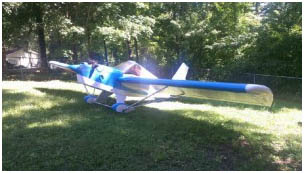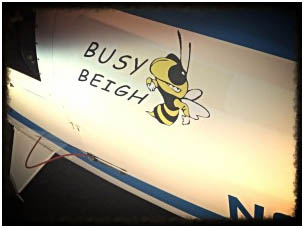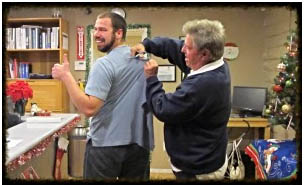Following in Grandpa’s Footsteps: Sean Winship inspired to fly by grandfather’s Mini-Max
From ChapterGram Newsletter, June 2014
What grandson doesn’t look up to his grandfather, especially when he’s building an airplane in his garage? Such a feat is an amazing challenge and adventure to an adult, but to a child, it’s pure magic! Sean Winship, EAA 1129870, grew up admiring his grandfather, who lived on a private grass strip in Florida and owned a Mini-Max airplane that he built when Sean was just 12 years old. “I thought it was the best thing ever,” Sean recalled.
About a year ago, Sean was driving home to Tennessee from Kentucky when memories of his grandfather’s Mini-Max entered his mind during the long drive. Sean decided to call his grandpa to remind him of how the tailwheel airplane and his hobby of flying came about.
Well, lo and behold, one year after that chat, Sean became a private pilot, trained by flight instructor Steve Hosterman of Fly Corona in California. The dream of following in his grandfather’s footsteps and flying the Mini-Max airplane is not the only special element of this story. Sean also earned his wings in only 36.9 hours, beating the national average by almost half.
In Sean’s words, here’s how his grandfather ignited his interest at such a young age:
“There was a bit of distance between my grandfather and me, so we did not get much time together. [Sean lived a few hours away from his grandfather in Florida.] I remember visiting the week that he finished the build and remember thinking how prestigious it was that grandpa had an airplane…and he built it himself!
“While I was there, he gave me a collectible Timex airplane clock that I still have on my dresser today. A few months later, my parents told me that he wrecked the airplane during a taxi test with no harm to himself, so I figured all hopes of seeing him fly it were out the window.
“It was at that point that my fairly new passion for aviation went away for a bit since the plane was gone. I was devastated and remember daydreaming about what happened to grandpa and the plane. To my surprise, more than 10 years later when I called him about what kind of plane it was, he shared with me that he still had it! He told me that he didn’t have a wreck; he had a fuel issue from some faulty fuel lines, and he decided at that point that he could no longer safely fly due to his health. And so the plane was set up for storage in the year 2000.
“I never got a chance to fly with him because the Mini-Max has just one seat; and he had no other airplanes during my youth that I remember. But I will soon fly the Mini-Max in his honor [It will be the first official flight for the certificated plane], and I plan to take a commercial flight to Florida to see him and show him the first flight video in person. I cannot wait to see him light up!”
During the time the Mini-Max has been undergoing a mild restoration, Sean has been studying and working hard on his flying skills. Sixty-seven flight-training hours is the average for most student pilots to receive their private pilot certificate. How did he do it so quickly?
In speaking to both Sean and his instructor, Steve, there are a few main characteristics that keyed Sean’s training and put him closer to his goal of flying grandpa’s plane.
Before arriving at Fly Corona, Sean said he prepared himself well. He studied and studied hard. He began an online ground course two months before arriving at the school and also purchased several FAA-approved books in order to be as knowledgeable as possible beforehand.
He notes that he’s known to be a “jack of all trades, master of some.” Being a master of some is likely related to his dedication to learning and resourcefulness. Sean definitely did his homework, and then some.
In addition to studying hard, Sean trained actively; he was extremely dedicated. Sean shared, “I flew at least twice a week and many times it was three flights in a week. I remember many ground school lessons with Steve in which something I learned about during my pre-studies came to life because I actually had to do it. To become familiar with the phonetic alphabet, I probably read over a thousand license plates phonetically during my first month of training. I also remember lying in bed pretending to be flying the plane and would go through procedures and checklists in my mind. I thought about and talked about aviation and my training at all times.”
Sean took an introductory flight in mid-October 2013, began active training the first week of November, and passed his checkride on January 25, 2014. Although it can be done, this is not the average. Sean pushed hard to reach his goal. He also recognized his instructor as part of his path to success.
Sean praised his flight instructor for balancing encouragement with accountability. “He encouraged me every step of the way and held me accountable at the right times to make me want to keep moving forward, especially when I was struggling in my progress,” Sean said.
Sean also credits the curriculum that Fly Corona uses. Fly Corona is an FAA-approved Part 141 flight school which means training is more structured and strict, allowing students the advantage of knowing they are learning the best practices out there and receiving overall high-quality instruction. But don’t let “strict” scare you; these flight instructors are plenty of fun.
“I’ll never forget my final landing with Steve before my first solo flight,” Steve recalled. “Coming down final, he said, ‘This is the last one before solo - water my eyes.’ So I performed very well, landed the plane like a pro, and he said, ‘NTSB - you know what that means?’
“I began thinking to myself, isn’t that the National Transportation Safety Board? But before I could say what I was thinking, he says, ‘Not too shabby, bubba!’ From that day forward, “NTSB” became a small part of every flight that I will never forget.
“I also remember Steve cutting the back of my shirt out, a tradition for the first solo flight, and everyone at Fly Corona smiling, congratulating, and shooting pictures. It was such a fun day!” Steve also recalled flying with the assistant chief flight instructor, just before his first solo flight.
“As I turned final about a mile before landing, I got quiet so I could focus because we were talking a lot. And he began poking me in the arm, laughing, telling me that someday I will be flying and the kids in the back will be very distracting; and I have to learn how to deal with it. That was a lot of fun, too! There are many memories just like those that I will cherish for the rest of my life.”
Having had such rapid success in achieving his aviation goals, Sean offered the following advice to new flight students.
- Start ASAP - this flying stuff is great!
- When you start training, don’t stop.
- Trust your instructor - he wants you to succeed.
- When you get your license, keep the learning mentality for life.
- Immerse yourself in aviation; it will be worth it.
Soon Sean will start pursuing his tailwheel endorsement so he can achieve the goal of flying grandpa’s Mini-Max, which he moved from his grandpa’s Florida home to his house in Tennessee where the restoration work began.
Now it sits in his garage in California, receiving the final restoration touch-ups while it awaits its “maiden voyage.” In the meantime, he said he’ll be back at Fly Corona to grab some time in the school’s Cessnas and continue earning his complex and high-performance endorsements someday.
If you happen to see Sean around the school, make sure to say hi, congratulate him, and don’t hesitate to ask him for a piece of advice. Maybe he has some more tricks up his sleeve along the lines of reading license plates phonetically to fine-tune your radio communication skills.



